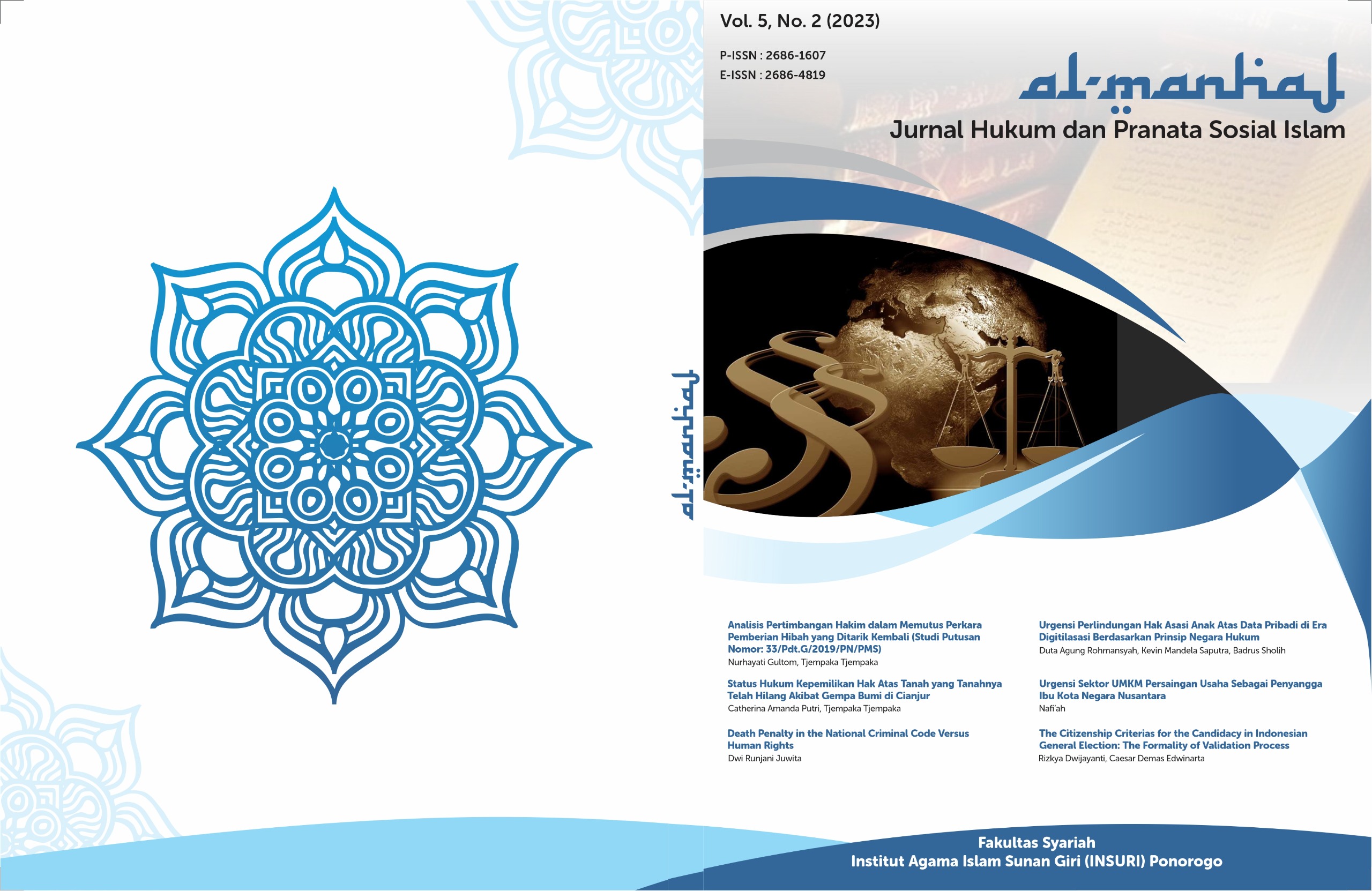Perbandingan Pendekatan Restorative Justice dan Sistem Peradilan Konvensional dalam Penanganan Kasus Pidana
DOI:
https://doi.org/10.37680/almanhaj.v5i2.3812Keywords:
Restorative Justice Approach; Conventional Justice; Criminal CasesAbstract
This research aims to compare restorative justice and conventional justice systems in the handling of criminal cases. In this context, it can be understood to comprehend the differences, similarities, and the impact of both approaches in the context of law enforcement and criminal justice. A qualitative approach is employed to gain a deep understanding of the characteristics, similarities, and differences between the two approaches in a practical context. Research data is obtained through in-depth interviews with actors involved in the criminal justice system, such as judges, prosecutors, law enforcement officers, social workers, offenders, and victims. The results of this research depict similarities in the focus on achieving justice and community protection between both approaches. However, fundamental differences emerge in their primary goals, with Restorative Justice emphasizing reconciliation, recovery, and conflict resolution, while the conventional justice system tends to lean more towards punishment as a form of retribution. The Restorative Justice approach assigns a more active role to victims in the process of handling criminal cases, enabling them to speak and participate in the recovery process. Meanwhile, the conventional justice system often follows a formal and adversarial process. This research has significant implications for understanding how both approaches can contribute to achieving fair and effective justice goals. The results of this research can be used as a basis for formulating better policies in handling criminal cases.
References
de la Feria, R. (2020). Tax Fraud and Selective Law Enforcement. Journal of Law and Society, 47(2), 240–270. https://doi.org/10.1111/JOLS.12221
Flora, H. S. (2017). Pendekatan restorative justice dalam penyelesaian perkara pidana dalam sistem peradilan pidana di Indonesia. Law Pro Justitia, 2(2). Retrieved from https://ejournal-medan.uph.edu/lpj/article/view/247
Irawan, B. (2019). Institutional Pluralism Sistem Peradilan Indonesia dan Kekuatan Negara di Era Globalisasi. Jurnal Borneo Administrator, 15(3), 237–256. https://doi.org/10.24258/JBA.V15I3.436
Irvan Maulana, M. A. (2021). Konsep dan Implementasi Restorative justice di Indonesia. DATIN LAW JURNAL, 2(2), 46–70. https://doi.org/http://dx.doi.org/10.36355/dlj.v1i1
Karjoko, L., Handayani, I. G. A. K. R., Jaelani, A. K., Barkhuizen, J., & Hayat, M. J. (2021). The Urgency of Restorative Justice on Medical Dispute Resolution in Indonesia. AL-IHKAM: Jurnal Hukum & Pranata Sosial, 16(2), 362–392. https://doi.org/10.19105/AL-LHKAM.V16I2.5314
Khotib, D. K., Hidayat, I., Priyadi, A., Purwendah, E. K., & Artikel, I. (2020). Kajian Kritis Terhadap Dualisme Pengadilan Elektronik (E-Court) dan Konvensional. Batulis Civil Law Review, 1(1), 14–23. https://doi.org/10.47268/ballrev.v1i1.421
Legowo, P. S., & Taufiq, M. (2023). Analisa Sistem Peradilan Pancasila Dengan Sistem Peradilan Konvensional. Soedirman Law Review, 5(1). Retrieved from http://journal.fh.unsoed.ac.id/index.php/SLR/article/view/3481
Muhaimin. (2019). Restoratif Justice dalam Penyelesaian Tindak Pidana Ringan. Jurnal Penelitian Hukum De Jure, 19(2), 185–206. https://doi.org/10.30641/DEJURE.2019.V19.185-206
Murdiyanto, D. E. (2020). Metode Penelitian Kualitatif (1st ed.). Lembaga Penelitian dan Pengabdian Pada Masyarakat UPN ”Veteran” Yogyakarta Press.
Nuraeni, Y., & Sihombing, L. A. (2019). Kebijakan Hukum Pidana terhadap Restorative Justice dalam Perspektif Hak Asasi Manusia. Jurnal Hukum Positum, 4(1), 84–97. https://doi.org/10.35706/POSITUM.V4I1.3009
Ramadhanti, S. N., Nurensa, A., & Rianto, S. A. (2022). Konsep Restorative Justice Dalam Perbandingan Hukum Pidana Di Indonesia Dengan Hukum Islam. PESHUM : Jurnal Pendidikan, Sosial Dan Humaniora, 1(4), 417–423.
Riswandie, I. (2023, July 1). Perlindungan hukum bagi masyarakat marginal dalam perspektif asas “equality before the law.” SULTAN ADAM : Jurnal Hukum Dan Sosial, Vol. 1, pp. 298–310. Retrieved from http://qjurnal.my.id/index.php/sultanadam/article/view/545
Setyowati, D. (2020). Memahami Konsep Restorative Justice sebagai Upaya Sistem Peradilan Pidana Menggapai Keadilan. Pandecta Research Law Journal, 15(1), 121–141. https://doi.org/10.15294/PANDECTA.V15I1.24689
Sunarso. (2022). Viktimologi dalam sistem peradilan pidana. Sinar Grafika.
Ternando, A. (2023). Penegakan Hukum Terhadap Restorative Justice Dalam Sistem Peradilan Pidana Di Indonesia. JURNAL RECTUM: Tinjauan Yuridis Penanganan Tindak Pidana, 5(1), 1386–1401. https://doi.org/10.46930/JURNALRECTUM.V5I1.3168
Tripa, S. (2019). Diskursus Metode dalam Penelitian Hukum. Bandar Publishing.
Zulfa, E. A. (2020). Implementation of Restorative Justice Principles in Indonesia: A Review. International Journal of Science and Society, 2(2), 317–327. https://doi.org/10.54783/ijsoc.v2i2.161
Downloads
Published
How to Cite
Issue
Section
License
Copyright:
- Author retains the copyright and grants the journal the right of first publication of the work simultaneously licensed under a Creative Commons Attribution 4.0 International License that allows others to share the work with an acknowledgment of the work's authorship and initial publication in this journal.
- Author is able to enter into separate, additional contractual arrangements for the non-exclusive distribution of the journal's published version of the work (e.g., post it to an institutional repository or publish it in a book) with the acknowledgment of its initial publication in this journal.
- Author is permitted and encouraged to post his/her work online (e.g., in institutional repositories or on their website) prior to and during the submission process, as it can lead to productive exchanges, as well as earlier and greater citation of the published work (See The Effect of Open Access).
License:
-
Attribution — You must give appropriate credit, provide a link to the license, and indicate if changes were made. You may do so in any reasonable manner, but not in any way that suggests the licensor endorses you or your use.
-
No additional restrictions — You may not apply legal terms or technological measures that legally restrict others from doing anything the license permits.
You are free to:
- Share — copy and redistribute the material in any medium or format
- Adapt — remix, transform, and build upon the material for any purpose, even commercially.

This work is licensed under a Creative Commons Attribution 4.0 International License.














